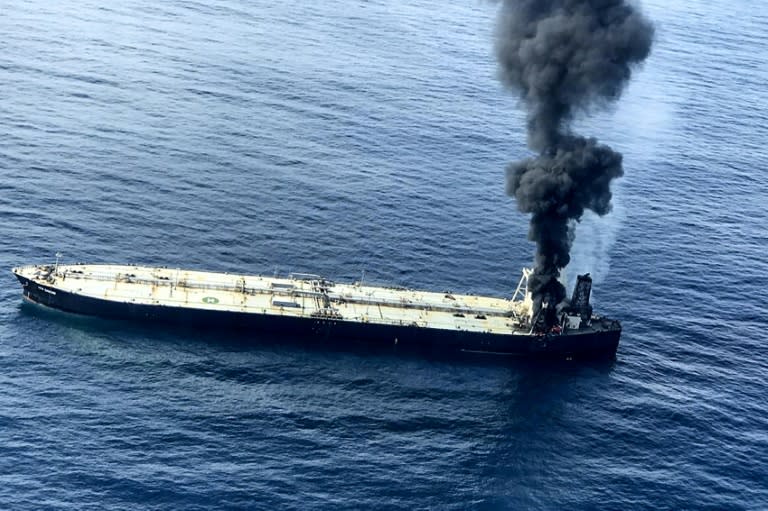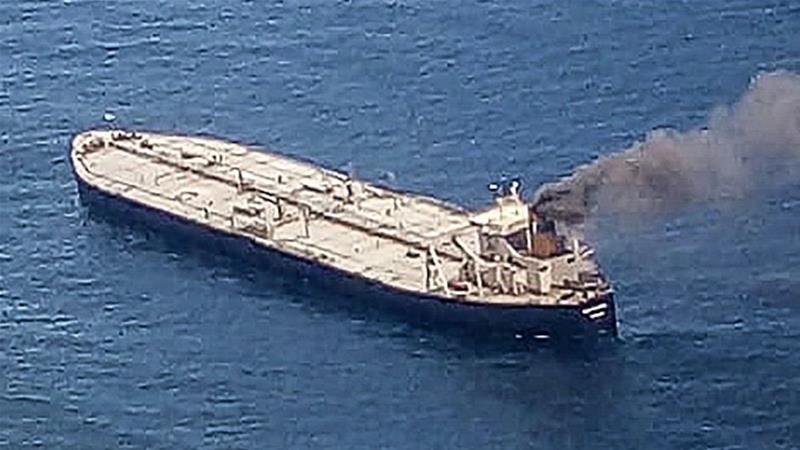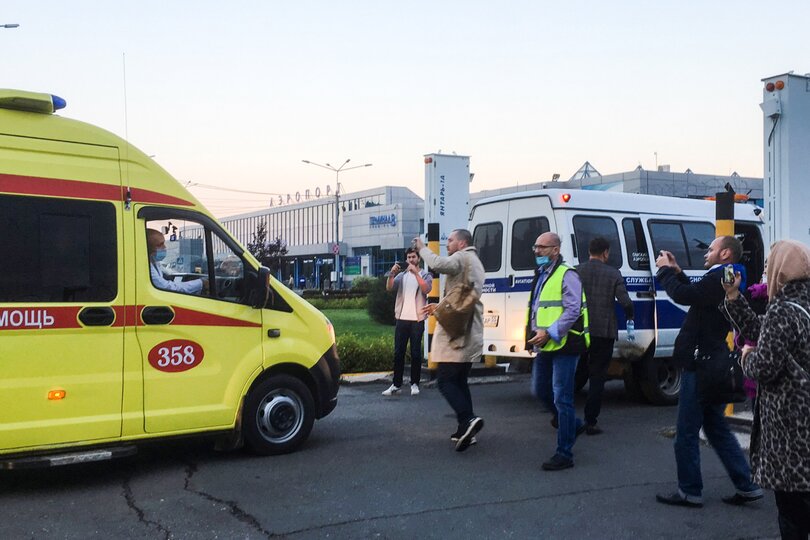U.S. Troops in Syria Stuck Fighting 'Forgotten War' for Oil as Russia Advances Around Them
Trump Says It's Time U.S. Passes War On ISIS To Russia, Iran, Iraq And Syria, Focuses On Oil Instead
A Growing number of incidents involving U.S. and Russian forces in Syria has highlighted yet another strategic blindspot in the Middle East for Washington, as its shifting politics leave U.S. troops essentially stranded to guard oil and gas resources while Moscow presses on with a five-year effort to stabilize the war-torn nation.
With no clear path forward, a range of voices within the U.S., Russian and Syrian governments, and on the ground in areas under the control of a Pentagon-backed autonomous administration in the country, have expressed doubts to Newsweek over the current approach.
"It's a clusterf**k in Syria," one senior U.S. intelligence official, who requested anonymity because they were not authorized to speak to the media, told Newsweek. "We don't have a strategy."
The frustrations come as the U.S. nears an election in which both candidates vow to end the "endless wars" waged by their predecessors. Come January, either former Vice President Joe Biden—who oversaw U.S. support for insurgents fighting to overthrow the Syrian government under former President Barack Obama—or President Donald Trump—who inherited a campaign then focused on fighting the Islamic State militant group (ISIS)—will steer a U.S. policy on Syria that is currently presented with mixed messages, even among the government's own agencies.
Officially, the Pentagon's mission remains "to ensure an enduring defeat" of ISIS, according to the most recent press releases sent to Newsweek by the U.S.-led coalition. The State Department additionally calls for Syrian President Bashar al-Assad to negotiate his departure, and for the withdrawal of Iran and Iran-backed forces supporting him.
For his part, President Trump, as he told reporters last month, said the U.S. has simply "kept the oil."
The president has made no secret of his desire to send U.S. oil companies to operate in Syria, and to let others such as Moscow, Tehran and Damascus take on the task of preventing a resurgent ISIS. Last October, he repositioned personnel away from outposts under the control of the mostly Kurdish Syrian Democratic Forces, and sent what he called a "small force" of U.S. troops to guard oil and gas fields in the northeast.
Russia, for its part, seized the opportunity to expand its presence in support of the Syrian government, taking control of former U.S. positions in some cases. Now two of the world's most powerful militaries led by geopolitical rivals operate side-by-side in northeastern Syria, with only a deconfliction channel to prevent accidents.
"The Coalition does not coordinate or share intelligence with Russia in Syria," Pentagon spokesperson Navy Commander Jessica McNulty told Newsweek. "From time-to-time we are incidentally apprised of planned Russian strikes on ISIS targets West of the Euphrates River, as part of our routine de-confliction communications."
This precarious situation has resulted in a number of international incidents involving U.S. and Russian forces apparently trying to block one another's patrols as they occupy the same roads in northern and eastern Syria.
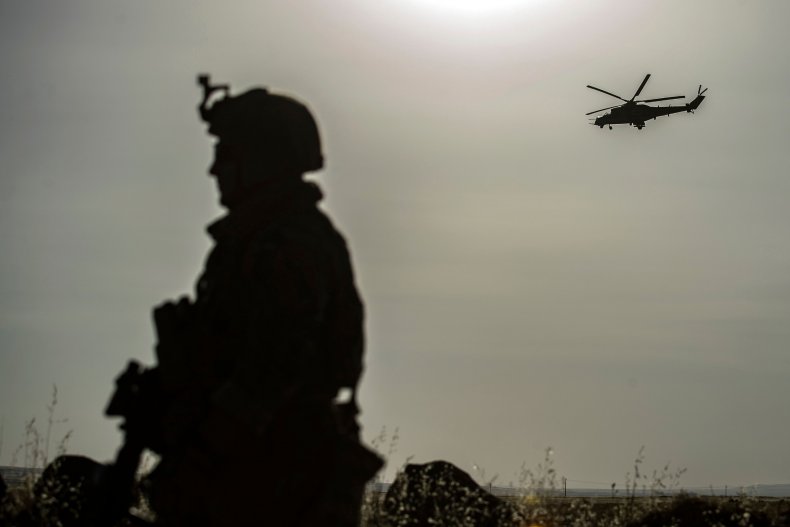
A picture taken on June 3 shows a U.S. soldier standing guard as a Russian Mil Mi-24 military helicopter gunship flying over the northeastern Syrian town of Al-Malikiyah at the border with Turkey. Moscow backs the Syrian government based Damascus, Washington supports an autonomous and mostly Kurdish-led administration in the north and east, while Ankara sponsors an insurgency along the border and in northwestern Idlib province.DELIL SOULEIMAN/AFP/GETTY IMAGES
One high-profile instance last week saw U.S. troops injured after their vehicle collided with a vehicle of the Russian forces. The Pentagon said that the incident demonstrated "deliberately provocative and aggressive behavior" by the Russians.
"We have advised the Russians that their behavior was dangerous and unacceptable," the Pentagon said in a statement. "We expect a return to routine and professional deconfliction in Syria and reserve the right to defend our forces vigorously whenever their safety is put at risk."
The senior U.S. intelligence official who spoke to Newsweek characterized Moscow's moves as posturing.
"The Russians are and will be aggressive, that's their definition of 'strength,' and at times it's as simple as not properly deconflicting routes, patrols, etc.," the official said.
The dust-up led to a call between the top military officials of the two countries. During the discussion, Russian Chief of the General Staff Army General Valery Gerasimov told U.S. Joint Chiefs of Staff Chair Army General Mark Milley that "the commanders of the International anti-terrorist coalition were notified in advance of the Russian military police convoy," according to remarks delivered by Kremlin spokesperson Dmitry Peskov and shared by the Russian Foreign Ministry.
Gen. Gerasimov proceeded to blame the U.S. military for the collision between the forces of the two countries.
"Despite this, in violation of existing agreements, U.S. military personnel attempted to block a Russian patrol," he added. "In response to this, the military police of the Russian Federation Armed Forces took the necessary measures to prevent the incident and further fulfill their task."
READ MORE
Syria Says Trump 'Stealing' Its Oil, After U.S. Company Makes Deal to Drill
Moscow's argument is based on the premise that the U.S. does not have the right to be in Syria in the first place.
"We proceed from the fact that American military presence in Syria (both in At-Tanf and in the Northeast) is illegal," Nikolay Lakhonin, a spokesperson for the Russian embassy in Washington, told Newsweek. "Neither the U.N. Security Council, nor the government in Damascus gave their approval for the U.S. to deploy troops."
Not only deeming it illegitimate, Moscow argues the presence of U.S. troops in Syria has exacerbated the suffering of its population.
"Besides the clear violation of international law, American presence in Syria has an undeniable negative impact on the lives of Syrians," he added. "By occupying major oil and gas reserves in the Northeast, the U.S. deprives the people of Syria from its own vital resources."
Lakhonin also warned of "severe humanitarian effects" such as in the Syrian Democratic Forces-run Al-Hol camp in Al-Hasakah and Al-Rukban camp in U.S.-backed insurgent-held Al-Tanf. Both refugee sites have been regular subjects of desperate U.N. appeals, which are also directed toward civilians caught in bombardments by Russia and Syrian warplanes.
While Western powers still disregard Assad over war crime accusations, Russia sees his leadership as the only path forward.
"In our contacts with the U.S. officials," Lakhonin said, "we urge them to end this illegal occupation, and let the Syrian government restore control over its legally recognized territories."
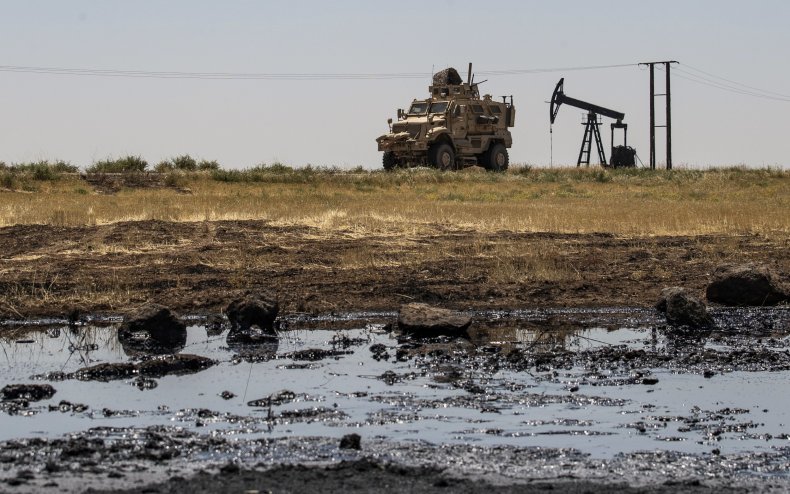
A U.S. armored vehicle drives past an oil field in the countryside of Al-Qahtaniyah town in Syria's northeastern Al-Hasakah province near the Turkish border, on August 4. "In Syria, we're down to almost nothing, except we kept the oil," President Donald Trump said last month. "We did keep a small force, and we kept the oil."DELIL SOULEIMAN/AFP/GETTY IMAGES
Damascus' ambassador to the United Nations, Bashar Jaafari, also condemned U.S. policy in Syria. He too took note of Trump's public enthusiasm in tying U.S. military presence in Syria to oil, and challenged the legitimacy of this deployment in remarks delivered to the U.N. Security Council and sent to Newsweek by the Syrian U.N. mission.
"The U.S. occupation forces, in full view of the United Nations and the international community, took a new step to plunder Syria's natural resources, including Syrian oil and gas," Jaafari said, through a company he called "Crescent Delta Energy."
A similar name, "Delta Crescent Energy," appeared in U.S. outlets citing sources familiar with the arrangement. The State Department later confirmed that the U.S. government had facilitated such a license, though the Treasury Department declined to offer details to Newsweek as a matter of legal protocol.
Jaafari went on to accuse the U.S. of theft, saying that it was "stealing Syrian oil and depriving the Syrian state and Syrian people of the basic revenues necessary to improve the humanitarian situation, provide for livelihood needs and reconstruction."
The vehicle crash between U.S. and Russian forces in Syria is not an isolated incident among rival forces. In another confrontation about a week earlier, a tense situation reportedly turned deadly at a Syrian military checkpoint in the same northeastern province of Al-Hasakah. The Syrian government accused the U.S. of killing one of its soldiers and wounding others, while the U.S.-led coalition troops said they had returned fire after being shot at.
Meanwhile, the ebb and flow of various armed factions have taken a toll on the local population of northern and eastern Syria, which has become increasingly suspicious of Washington's true intentions.
Mohammed Hassan, a Syrian Kurdish fixer and journalist who has witnessed and recorded a number of U.S.-Russia encounters firsthand, said the two countries' diverging strategies were readily apparent.
"The strategy for the Russian forces is to be deployed in all of north and eastern Syria," Hassan told Newsweek. "They are planning to do this, but about the Americans, they are just interested in the oil and gas fields in areas like Rmelan, like Al-Hasakah, like Al-Shaddadi, like Al-Hol and like Deir Ezzor."
Hassan said that the United States Syria policy is all about the oil.
"We all know about the American withdrawal from Kobani, from Manbij, from Ayn Issa, from Ras al-Ayn, from Tel Abyad," he said. "We know there are not any oil and gas fields there."
Hassan recalls scenes last October of teary-eyed civilians throwing stones at departing U.S. military convoys, shouting as they feared an imminent Turkish invasion. The incursion was partially halted by successive U.S. and Russian deals with Turkey, but Hassan said the views of locals armed and unarmed toward the U.S. fundamentally shifted after this decision.
"All of us will remember how this relationship between the Americans and local civilians changed," Hassan told Newsweek. "I remember this moment until now. I cannot forget it ever."
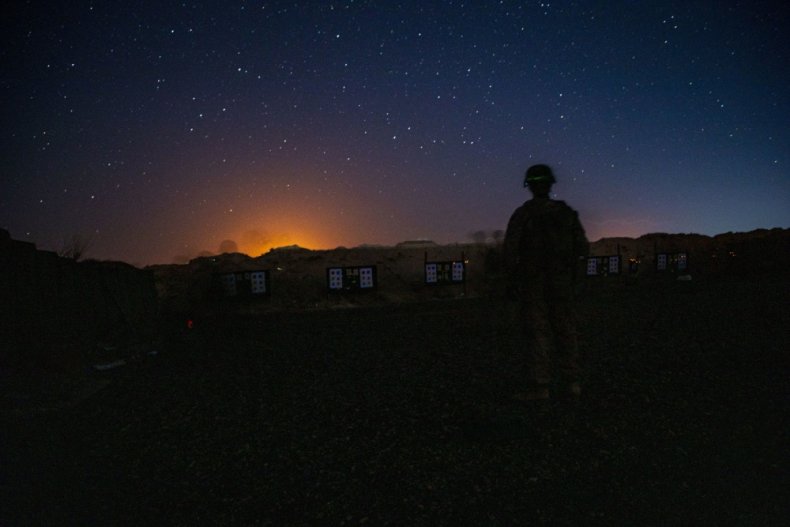
U.S. Marines with 2nd Battalion, 5th Marine Regiment take part in a combat marksmanship range in Syria, August 21. There are roughly 500 U.S. troops deployed to Syrian Democratic Forces-controlled northerm and eastern Syria as well as a southern garrison in the opposition-held Al-Tanf region.SERGEANT BRENDAN CUSTER/13TH MARINE EXPEDITIONARY UNIT /U.S. MARINE CORPS
Russia has since hosted meetings with officials from Turkey, Iran, the Syrian government and its opposition, and the Syrian Democratic Forces' political wing. Each side is struggling to find common ground with the other in a conflict that will reach its deadly tenth anniversary next March.
That same month will mark two years since President Trump declared victory over ISIS, the primary goal for a mission that Washington has yet to officially replace. Still, U.S. troops linger in a country accounting for a mere .2 percent of the world's proven oil reserves and .12 percent of gas reserves.
"I think that American strategy here it's not clear enough, especially on the politics side," Hassan said. "Maybe on the military side, it's clear in some ways. I think the mission for the American forces here, it's successful, but the political mission, it's not successful."
Malcolm Nance, a former U.S. Navy intelligence and counter-terrorism specialist, put the situation in perspective, comparing it to another bloody quagmire for the Pentagon.
"A few special forces supported by artillery and armor units is very much akin to 2002 in Afghanistan," Nance said. "It is now a forgotten war."
Like Hassan, Nance saw a political game with little payoff.
"The oil fields that U.S. forces are now occupying do not produce anything that comes to North America, and has no value save either for Russia and the Assad regime or the SDF allies whom we have abandoned," he told Newsweek. "Trump is sitting on this field and risking U.S. lives to say 'we took their oil.'"
The irony, Nance says, is that while there are oil fields, little is actually produced.
"The oil remains in the ground, the fields are unworked," Nance said, "and U.S. soldiers are dying to fulfill a feeble man's pledge."
